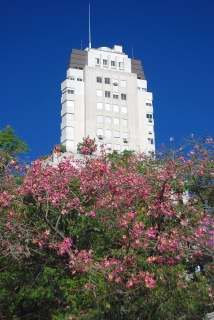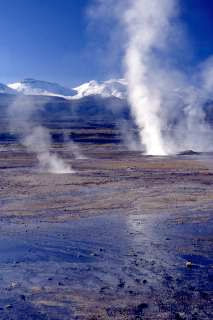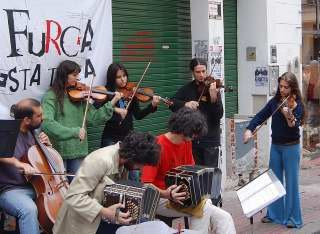Six years ago, in 2002, I was preparing the first edition of
Moon Handbooks Buenos Aires in the midst of Argentina's dramatic economic and political meltdown.

In the course of doing so, I paid a visit to a downtown hotel that had had the misfortune to reopen, at this worst possible time, as part of an international chain (not the Sheraton, pictured here). Given its location, barely a block from the chaos of the Plaza de Mayo, and the fact that tourism and business travel had come to a virtual halt, the hotel in question was nearly empty.
My story was that I was looking for a place to house my elderly parents, who were coming to visit, and that my small apartment did not have sufficient room for them, but my real purpose was to inspect the hotel anonymously. Normally I would expect the bellman to show me a room or two, and the hotel's common areas, but in this case I was asked to wait a few minutes as the concierge made a phone call. Imagine my surprise when the hotel manager emerged from her office to give me an exhaustive tour of the spectacularly recycled building, a neighborhood classic. Business was so slow that they had to put out every effort to attract even a single guest.
When I asked the price, the manager told me it was normally US$100 - in fairness, not an unreasonable price for a hotel of this standard in almost any country in the world - but, she added, "because you're living here, I can offer it for the 'local price'" of 100 pesos - closer to US$30. Today, following Argentina's recovery and persistent high inflation, rates at that same hotel start at US$150 plus taxes, and most rooms go for more.
This, however, was the first experience I had with "differential prices" which, over the last several years have become a plague and an excuse to rip off foreign tourists even as Argentine prices return to their pre-crisis levels, when the dollar and peso were one to one (at present, the dollar is slowly regaining strength against the Argentine currency). In March, the federal government finally acknowledged the problem by passing a Defensa del Consumidor (Defense of the Consumer) law that prohibits differential rates in hotels and other services, but the problem has not gone away. According to the Buenos Aires daily
Clarín, in hotels, restaurants and taxis, services often continue to cost more to the client who's obviously foreign. In some extreme cases, advertised peso prices are claimed to be dollars or even euros - three or four times the true cost (Argentines also use the "$" symbol to denote pesos in everyday transactions).
One Recoleta artisan quoted by Clarín summed up the problem: "I charge whatever I want, because I'm the one who fixes the value of my labor." Caught giving a discount to an Argentine customer, though, he retorted that "The foreigner has more money than I do." In some cases, it's a little more subtle - when I went to dinner with my Argentine cousin and her husband in the Patagonian resort of El Calafate, for instance, a top restaurant gave us a 20 percent discount because they were locals (even though they're doing very well as freelance guides in Calafate's flourishing tourist economy).
The danger of all this, of course, is that foreigners will start to view Argentines as shameless opportunists who will do anything for a peso, dollar, or euro, and decide never to return - and to tell their friends not to bother going. For an individual or a business, overcharging a foreigner has short-term advantages; for the country as a whole, it could be disastrous. In general, prices are still reasonable, but Argentina doesn't need anything that would further erode its competitive advantage in the travel and tourism sector.
 pretty good deal - nearly three times the price he had paid in pesos - but had he sold a few months earlier, when the peso was at par with the dollar, he would have done even better.
pretty good deal - nearly three times the price he had paid in pesos - but had he sold a few months earlier, when the peso was at par with the dollar, he would have done even better.





































